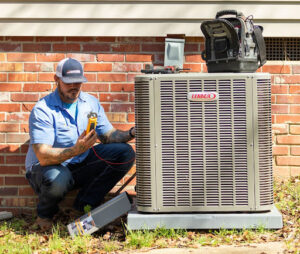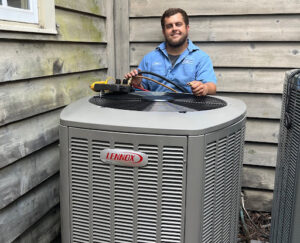Sump pumps are unsung heroes in preventing devastating and costly water damage. These devices provide the first line of defense against basement, crawl space, or low-lying area flooding.
If you’ve recently moved into a home with a sump pump or are simply unfamiliar with these devices, it’s completely understandable if you have questions. You might be asking, “What is a sump pump, and how does it work?”
Fortunately, learning how a sump pump works isn’t too difficult. If you’ve been thinking about installing a sump pump, learning the ins and outs of these devices can help you make an informed decision. Let’s go over everything you need to know below.
What Are Sump Pumps?
So, what is a sump pump, and how does it work? We’ll start by answering the first half of this question.
In the simplest sense, a sump pump is a device that removes water from a basement, crawl space, or low-lying area and transports it outdoors. Each device includes various components, such as a sump pit (basin), a discharge pipe, and valves.
Depending on your home’s size and the specific amount of rainfall you receive, you’ll need to choose a sump pump that meets your horsepower requirements. If your basement is incredibly close to the water table and you experience heavy rains, you’ll certainly want to consider installing a sump with higher horsepower. Of course, it’s a good idea to discuss your options with a professional installer before making a decision.
Installing a sump pump is one of the best ways to avoid a flooded basement, crawl space, or low-lying space. However, it’s critical to be aware of the fact that there are different types of sump pumps on the market. We’ll discuss these pumps in more detail.
Submersible Pumps
Submersible sump pumps have a pump and motor that are installed, or “submerged,” in the sump pit. A lid will often be placed on top of the basin, which can help prevent various types of debris from getting inside.
Since everything is placed and enclosed within the basin, these devices are known for quieter operation. However, they may have higher upfront costs than their pedestal pump counterparts.
Pedestal Pumps
As the name suggests, pedestal sump pumps are designed so that the motor is placed on a pedestal above the sump pit and out of the water. These devices are typically the better option if you’re looking for easy installation and maintenance. However, these sump pumps can be on the noisier side and take up more space.
How Does a Sump Pump Work?
Now that you know what these devices are and how they can benefit your home, it’s crucial to know how a sump pump works. Fortunately, the process is pretty simple to understand. Sump pumps have float switches that detect rising water levels. When the water in your basement or crawl space, or low-lying area rises to a certain level, the sump pump will immediately switch on to start removing the water from your home.
A discharge pipe removes the water from the basement, crawl space, or low-lying area. Sump pumps also have one-way check valves that prevent the water from accidentally flowing back into the pit. These devices also run on electricity, so they must be connected to an outlet with a ground fault circuit interrupter (GFCI). GFCI outlets prevent electrocution by cutting off the power when a ground fault occurs.
Sump Pump Backups
So, what is a sump pump, and how does it work when the power goes out? Unfortunately, since sump pumps run on electricity, they aren’t capable of functioning during a power outage. One way to overcome this issue is by investing in a backup pump. There are various types of backups available, but some of the most popular ones are battery backup sump pumps.
Now that you know how a sump pump works, you have a good idea of how these backup devices will work. Backup sump pumps work in much the same way as primary pumps, but they usually have a shorter service life due to their batteries. When the battery drains, the backup will no longer be able to work.
How Long Do Sump Pumps Last?
On average, sump pump systems can last anywhere from seven to ten years before they need to be replaced. Of course, the lifespan of your sump pump can vary depending on several factors, including regular maintenance, usage, and run time.
Should You Install a Sump Pump?
Now that you know how a sump pump works, you might be wondering if you need to have a pump installed in your home.
Although sump pumps aren’t required in low-lying spaces, they’re certainly worthwhile for many reasons. You’ll especially want to consider installing one of these devices if you experience frequent, heavy rains, your home is susceptible to flooding, or you have a basement that is close to the water table.
Install a Sump Pump Today With Environment Masters!
What is a sump pump, and how does it work? This is an important question for homeowners to know the answer to, especially if they have a basement, crawl space, or low-lying area.
Environment Masters makes installing a sump pump a quick and easy process! Our experts are proud to offer a wide range of plumbing installation services for the residents of Jackson, MS, and the surrounding areas. We specialize in sump pump installations, replacements, repairs, and maintenance — among many other top-tier solutions.
Don’t let flooding ruin your home. As one of the most dependable plumbing companies in Jackson, MS, we’ll help you install a sump pump that meets your needs. Contact us today to learn more about our services!





